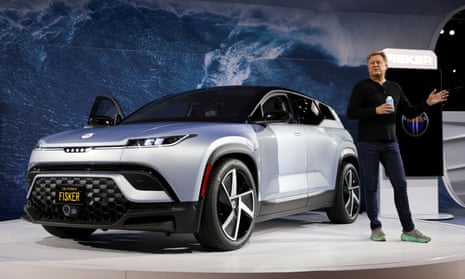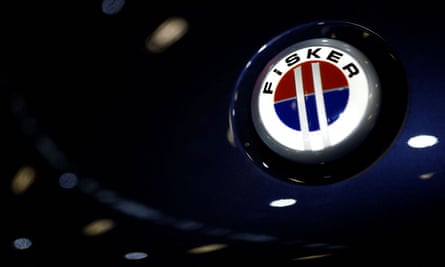After a failed first attempt, the car entrepreneur has revised his design and manufacturing ideas – and will have battery-powered vehicles ready for delivery next month

Henrik Fisker is under no illusions about how hard it is to start an electric car company from scratch. He should know: his first attempt ended in bankruptcy. The second attempt is going better so far: his company, Fisker Inc, claims to be the only one of a batch of would-be Tesla challengers that has not had to push back its production schedule.
“Most of the startup companies are fairly naive at the beginning,” he says. “We didn’t have that. We knew it was going to be expensive. We know manufacturing is difficult.”
Times have been tough for electric vehicle startups. After seeing an extraordinary bubble during the bounceback from coronavirus, their stock market values have come down to earth with an almighty thump. Fisker Inc has not been immune: its market value of $2.3bn is less than a third of its peak value of nearly $8bn. Even Tesla is struggling to meet its delivery targets.
Yet Fisker is bullish. His company has now produced its first vehicles, and buyers of its Ocean SUV will start having them delivered in November. He says the firm will “definitely” produce 40,000 cars next year, and maybe as many as 50,000 if it gets the ramp-up right, he says, speaking via video call from California.
Despite burning through $228m in the first half of 2022, Fisker Inc is pushing ahead with developing two other cars: a family vehicle called the Pear that
CV
Age 59
Family Married to Geeta Gupta-Fisker, co-founder and chief financial officer of Fisker Inc. He has a daughter who also works in the company and a son who works for a tech company.
Education Primary school in Denmark; ArtCenter College of Design in Vevey, Switzerland.
Pay $56,800 a year. “But then again, I own a big chunk of the company,” he says. “I guess I don’t want to take any salary until we earn revenue and make money.”
Last holiday A half-day on the day of the interview. “I’m spending one hour of it with you.”
Best advice he’s been given
“My father says if you want it badly enough, and you work hard enough, you can get it. Anything is possible.”
Word he overuses “Super.”
How he relaxes Drawing cars, going to the gym, listening to music – James Bond theme tunes, anything from the late 1960s and early 70s to the present day. “I think the only thing I don’t listen to is rap music.”
will come in at under $30,000 (£27,000), and a “super-sexy supercar” designed in the UK and codenamed Project Ronin.
Like the bosses of several other electric car startups, Fisker mixes experience in the traditional car industry – at BMW and Aston Martin – with an environmentalist approach that handily aligns with the sales pitch for electric cars.
Born in Denmark, he inherited some of his concern for the environment from his parents when he was growing up in a village 18 miles from Copenhagen. He spent hours drawing cars as a child, and studied at a design college in Switzerland. His first job was at BMW, designing models such as the Z8 roadster, the car famously destroyed by a chainsaw suspended from a helicopter in the James Bond film The World Is Not Enough. (“That wasn’t a beautiful sight for me,” he sighs.)
After BMW, Fisker was headhunted by another Bond carmaker, Aston Martin, as part of a turnaround plan by then owner Ford. He designed the DB9 and the smaller Vantage, which, to keep costs down, shared parts and used the same production line. The Vantage became Aston’s all-time bestseller and made Fisker famous within the industry.
Despite this, Fisker Inc has not tried to imitate traditional carmakers. It will rely on an Austrian contract manufacturer, Magna Steyr, to build its car in Graz. Fisker puts that different approach down to the influence of his wife.
Fisker met Geeta Gupta-Fisker, who has a PhD in biotechnology from Cambridge, when she was working for the investment vehicle of property tycoon Vincent Tchenguiz. Fisker was pitching for investment in his first effort at an electric car company – confusingly named Fisker Automotive.
“No way,” was the answer, Fisker says. The personal relationship went better: they married in 2012. Now they are perhaps the motor industry’s power couple, with Gupta-Fisker serving as chief financial officer. They listed the stock in New York in October 2020 via a merger with a cash shell that provided $1bn it needed to launch its first car.
Using Magna’s factories, supply chains and expertise helped the couple to keep costs down, so they required less investment and could keep control of the company. This was a lesson Fisker learned from launching Fisker Automotive after doing some design consultancy, including a stint at Tesla, after he left Aston Martin.
Fisker now says 2011 was “too early” to launch a plug-in car, and blames the failure of that effort on the collapse of its battery supplier.
He compares the business model of the new Fisker Inc, which he founded in 2016, to Apple, which also relies on third-party contractors to actually manufacture the iPhones, while intellectual property and the enormous earnings remain in California.

He has taken the Apple imitation further, by teaming up with Apple’s key supplier, Taiwanese-owned Foxconn. It will build the Pear in a famous former General Motors factory in Ohio. Fisker has very high hopes for the project, which aims to start production in 2024, making 250,000 cars a year.
“The vehicle is radically different from anything you’ve seen on the road,” he says. The Pear will, for example, dispense with niche features such as adjustable suspension. “Of all the functions in a German luxury car, 70% are never ever used by the end buyer,” he says. “You’re paying for all that even if you never use it.”
Early teaser images of the Pear do not scream radicalism – it looks like a five-seater hatchback. However, what would be near-revolutionary is the intended price point, of less than $30,000.
“This is a little risky, because it’s not something people are familiar with,” he says.
“But on the other hand, we think, I think, and Foxconn think that the time is right for people to get a bit of a shock, of where the future is going.”